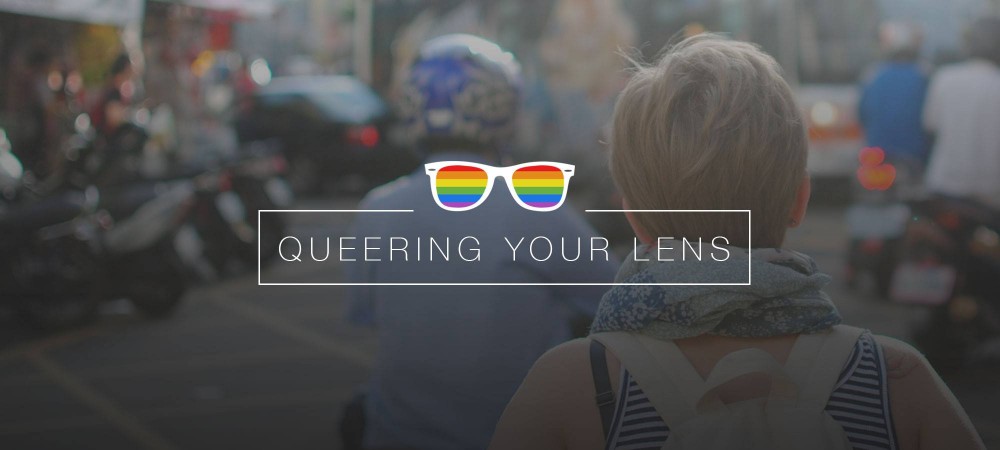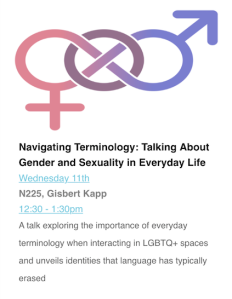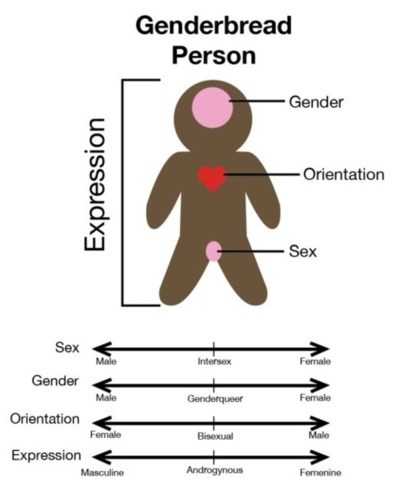After exploring the reasons why we have never heard about queer sex-ed in our schools in last week’s post, it’s time to imagine what queer sex education would look like.
And to imagine what queer sex-ed would look like, we need to keep in mind these four fundamental things as the foundation for our new sex-ed:
- Gender Is Not Binary, Gender Is A Spectrum:
Gender Identity is a person’s inner sense of self. This can be as man, woman, something other entirely or something in between. There are people, whose sex doesn’t match their gender identity, who identify as transgender.
Gender is a social construction because there’s nothing really natural, inherent or essential in a person’s gender identity. Society has constructed gender as a set of norms, roles and scripted expectations that determine how people within the gender binary (man and woman) should look, think and behave.
Our job as educators is to break the gender binary and construct gender as a spectrum. This means that a person’s gender is not about either/or, but about both/and. No one on this planet is made to perfectly fix society’s boxes of “men” and “women” and these categories are not in opposition against each other. Men have feminine traits in their character and vice versa. There are trans* folk who feel that they don’t belong to any gender or have traits of both of them and feel somewhere in between. There are people that feel another non-binary gender in its entirety. There are people that feel they have no gender identity at all.
- Sexual Orientation Is Not Fixed, Sexual Orientation Is Fluid
There are many sexual orientations! Think about all the labels people can choose to identify with: gay, lesbian, straight, bisexual, asexual, pansexual, queer or no label at all. We know sexual orientation is very diverse and, as such, it is not binary.
Sexual orientation is the sexual or romantic attraction (yes, they are separate things) a person feels towards other people. Much like gender, sexual orientation has nothing natural, essential or inherent about it. In fact, it only became an identity marker around the 19th century (thanks for the info, Foucault).
This attraction felt by people towards others is just pure desire and desire cannot be regulated or controlled by social norms. So, a person’s sexual orientation cannot strictly fit society’s boxes of “heterosexual”, “gay”, “bisexual” and so on. Identity is fluid and can change overtime, but this is not to say that everyone’s sexual orientation changes. Some people know they are gay and identify that way their whole life just as others ‘come out’ many times in their lifetime. It really depends on the individual and his, her or hir past experiences.
- Sex Is Not Just Male and Female, Sex Can Be Everything In Between:
Have you ever heard about a person being Intersex?
Just like gender identity and sexual orientation, biological sex is a spectrum. Some people are born with genitalia that is not exclusively male or female and/or with chromosomes other than XX and XY. Intersex people are born with biological traits that do not fit the sex binary of male/female and these traits can be chromosomal, hormonal and/or physical.
Our society tries to normalise these bodies through corrective surgery from the moment they are born. This is because our society wants to maintain the (binary and limiting) status quo regarding sex, gender and sexual orientation. All this is to preserve the privilege and power of those that are cis-het people with normative genitalia (because they are in power and are wary of people that are different taking their power… duh) *rolls eyes*
- Sex ≠ Gender ≠ Sexual Orientation
All these categories have one thing in common. This one thing is what our current sex-ed and society wants us to ignore: sex, gender identity and sexual orientation are not binary, black and white categorical boxes. These identity markers are diverse spectrums.
Sex, gender identity and sexual orientation do not determine each other, but are extremely linked and influence one another.
And guess what? All of these identities exist, all of them deserve respect and recognition and all of them are normal. So let’s start teaching sex, gender and sexuality as they really are and not as we’ve been conditioned to think they should be.
So what does this look like?
If queer sex-ed has as its foundation the four criteria explained above, it is automatically more inclusive and a more accurate representation of what sex, gender identity and sexuality really are. This means queer sex-ed needs to include traditionally marginalised voices within the queer movement like trans*, genderqueer, asexual, bisexual and intersex.
There are no assumptions of anyone’s gender identity, sex or sexual orientation and this means two things. Firstly, this creates a safe space and opens the conversation about how everyone feels and identifies, without being judged or considered an outcast. Secondly, the class needs to be taught accordingly, queering pedagogical methods (like using examples of queer people, asking for preferred pronouns, diversifying the literature to include queer voices).
Queer sex-ed should be leading the way towards a pleasure-based sexual health education. This means that, unlike abstinence-only education that focuses on babies and the (false) consequences of sex and contraception, queer sex-ed should be about learning to safely pleasure oneself and one’s partner. And this pleasuring should be without boundaries, which means acknowledging every gender identity and sexual orientation.
Queer sex-ed should be sex positive. Sex positive goddess Laci Green explains that sex positivity is about embracing one’s sexuality (no matter what that is) in a safe and consensual way. Sex positivity goes against the fear, shame and judgement that sex-negative societal attitudes seek to reproduce (mostly through sex-negative abstinence only ed), like slut-shaming. Sex-positivity calls for the freedom to express one’s sexuality alone or with a partner (or many!). But most importantly, sex positivity emphasises the need for consensual acts and advocates that only yes means yes. Important to say that ALL sexual relationships need consent, regardless of the genders and sexual orientations involved.
And last but not least, queer sex-ed should be body-positive. This means that part of sexuality education needs to focus on developing a positive and healthy relationship with our body image, regardless of gender and sexual orientation. This should focus on building acceptance, respect, love and admiration for our own bodies no matter what size we are. Also, to broaden our understanding of diversity, body-positivity fights against ableism, since this is another axis of oppression in relation to bodies in our society.
Surprisingly, there are a few organisations and academics (like me in the future, just saying) that are developing general guidelines and building curricula to queer sex-ed or make sex-ed queer. And this is not only regarding sex-ed, but to queer education in general. These awesome people have realised that in regular sex-ed, or even worse, abstinence-only education, queer sexualities and non-conforming gender identities are not only invisible, but they are considered threatening and immoral.
Think of the stigma, depression, loneliness, anxiety, sadness, bullying and other horrible consequences queer and trans* kids face in school (if not all of their lives) because they are taught that their experiences are considered unworthy of acknowledgement (to say the least!).

Credit: US Teen Culture
Beyond including facts and figures about the LGBTQIA+ community, queering sex-ed is about challenging the status quo. This surely sounds like big words to you, but it is indeed a big thing to celebrate. Queering sex-ed is about pushing boundaries and re-imagining the world we live in. And in doing so, paving the way towards a more equal and fair society.
Are you still not convinced of the need to teach a queer sex-ed? No? Okay. Just ask the following question: why is queer sex-ed important?
Well, basically because it is important that members of a marginalised community have the right to know how to have safe and consensual sex and be represented in the school curricula: LGBTQIA+ YOUTH. This type of education validates their experience in a world that constantly tells them that they are wrong and they shouldn’t exist.
This type of education promotes and promises LGBTQIA+ youth a better relationship and understanding of their identities, their bodies and their desires. They will learn how to have safe sex and enjoy it. They will learn how to prevent STIs and HIV. They will learn that consent is necessary in all kinds of relationship. They will learn that they too can form families.
Queer sex-ed not only benefits LGBTQIA+ students but everyone. This means that cisnormative heterosexual students can learn to accept and respect people that identify differently. This means that this cis-het students will learn about their identity privilege and will be encouraged to engage in active self-reflection about their role in oppressive structures.
Queer sex-ed dismantles the taboo status regarding sexual education (queer or not, to be honest!). It helps to see other identities and orientations as normal and helps dissolve the tension and fear of coming out. It will, by default, decrease the homophobic and transphobic bullying that is so rampant in our schools.
Queer sex-ed teaches gender identity, sexual orientation and biological sex as they actually are and not how we have been conditioned to think they should be.
So, I don’t know about you, but this sounds like my cup of tea 😉 I love me some queer sex-ed.
If you have any suggestions or ideas that you think should be included in queer sex-ed, please feel free to post them in the comment section 🙂







